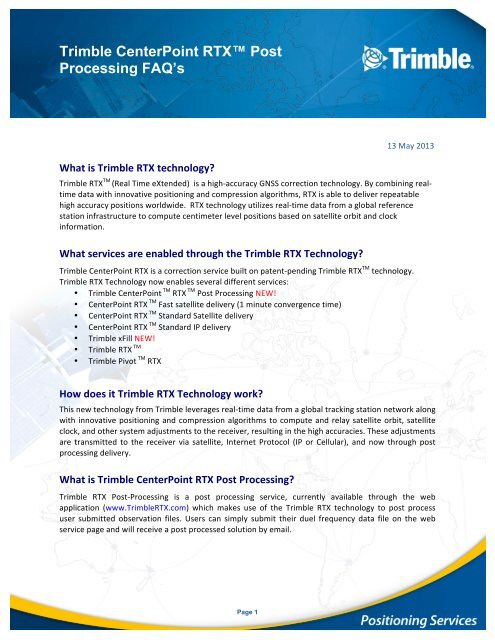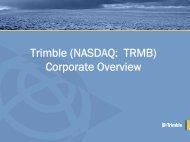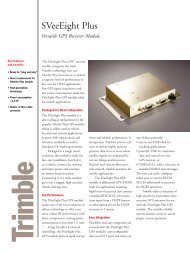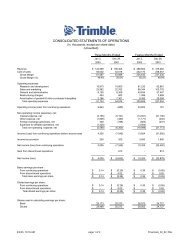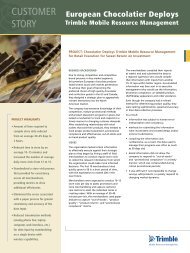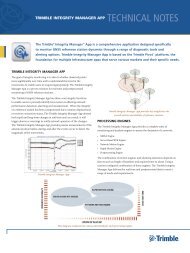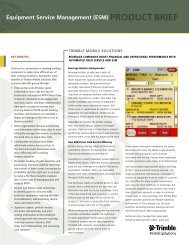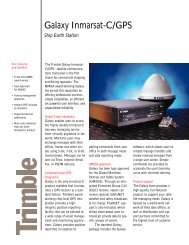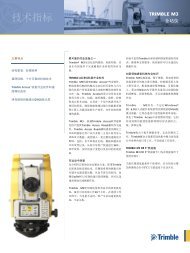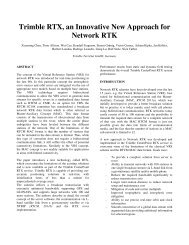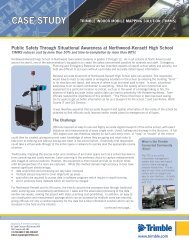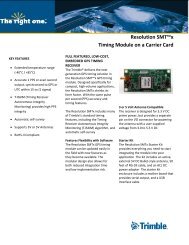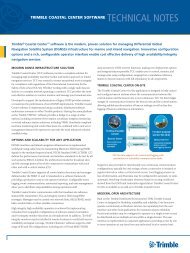Trimble CenterPoint RTX? Post Processing FAQ's
Trimble CenterPoint RTX? Post Processing FAQ's
Trimble CenterPoint RTX? Post Processing FAQ's
You also want an ePaper? Increase the reach of your titles
YUMPU automatically turns print PDFs into web optimized ePapers that Google loves.
<strong>Trimble</strong> <strong>CenterPoint</strong> <strong>RTX</strong> <strong>Post</strong><br />
<strong>Processing</strong> FAQ’s<br />
What is <strong>Trimble</strong> <strong>RTX</strong> technology?<br />
Page 1<br />
13 May 2013<br />
<strong>Trimble</strong> <strong>RTX</strong> TM (Real Time eXtended) is a high-‐accuracy GNSS correction technology. By combining real-‐<br />
time data with innovative positioning and compression algorithms, <strong>RTX</strong> is able to deliver repeatable<br />
high accuracy positions worldwide. <strong>RTX</strong> technology utilizes real-‐time data from a global reference<br />
station infrastructure to compute centimeter level positions based on satellite orbit and clock<br />
information.<br />
What services are enabled through the <strong>Trimble</strong> <strong>RTX</strong> Technology?<br />
<strong>Trimble</strong> <strong>CenterPoint</strong> <strong>RTX</strong> is a correction service built on patent-‐pending <strong>Trimble</strong> <strong>RTX</strong> TM technology.<br />
<strong>Trimble</strong> <strong>RTX</strong> Technology now enables several different services:<br />
• <strong>Trimble</strong> <strong>CenterPoint</strong> TM <strong>RTX</strong> TM <strong>Post</strong> <strong>Processing</strong> NEW!<br />
• <strong>CenterPoint</strong> <strong>RTX</strong> TM Fast satellite delivery (1 minute convergence time)<br />
• <strong>CenterPoint</strong> <strong>RTX</strong> TM Standard Satellite delivery<br />
• <strong>CenterPoint</strong> <strong>RTX</strong> TM Standard IP delivery<br />
• <strong>Trimble</strong> xFill NEW!<br />
• <strong>Trimble</strong> <strong>RTX</strong> TM<br />
• <strong>Trimble</strong> Pivot TM <strong>RTX</strong><br />
How does it <strong>Trimble</strong> <strong>RTX</strong> Technology work?<br />
This new technology from <strong>Trimble</strong> leverages real-‐time data from a global tracking station network along<br />
with innovative positioning and compression algorithms to compute and relay satellite orbit, satellite<br />
clock, and other system adjustments to the receiver, resulting in the high accuracies. These adjustments<br />
are transmitted to the receiver via satellite, Internet Protocol (IP or Cellular), and now through post<br />
processing delivery.<br />
What is <strong>Trimble</strong> <strong>CenterPoint</strong> <strong>RTX</strong> <strong>Post</strong> <strong>Processing</strong>?<br />
<strong>Trimble</strong> <strong>RTX</strong> <strong>Post</strong>-‐<strong>Processing</strong> is a post processing service, currently available through the web<br />
application (www.<strong>Trimble</strong><strong>RTX</strong>.com) which makes use of the <strong>Trimble</strong> <strong>RTX</strong> technology to post process<br />
user submitted observation files. Users can simply submit their duel frequency data file on the web<br />
service page and will receive a post processed solution by email.
Where is <strong>CenterPoint</strong> <strong>RTX</strong> <strong>Post</strong> <strong>Processing</strong> avaliable?<br />
<strong>CenterPoint</strong> <strong>RTX</strong> <strong>Post</strong> <strong>Processing</strong> is available for data files collected after May 14, 2011 – anywhere in<br />
the world.<br />
Who can use the <strong>CenterPoint</strong> <strong>RTX</strong> <strong>Post</strong> <strong>Processing</strong> service?<br />
<strong>CenterPoint</strong> <strong>RTX</strong> <strong>Post</strong> <strong>Processing</strong> is provided as an open service to all users of ‘supported receivers’. For<br />
more information, or to check if your receiver is supported visit<br />
http://trimble<strong>RTX</strong>.com/SupportedDevices.aspx.<br />
Is there any requirements of my observation file?<br />
Data files need to follow the following:<br />
• Accepted formats include: RINEX 2 and RINEX 3 data format and in <strong>Trimble</strong> proprietary data<br />
formats (e.g. DAT, T01, T02 files)<br />
• Data must be a minimum 1 hour in length but cannot exceed 24 hours<br />
• Data files can only be static<br />
• Data files need to contain duel frequency observations (L1/L2)<br />
• Receiver needs to be listed on the supported receiver list<br />
(http://trimblertx.com/SupportedDevices.aspx)<br />
• Data must have been collected after 14 May 2011<br />
What accuracy can I achieve?<br />
The achievable accuracy level of <strong>CenterPoint</strong> <strong>RTX</strong> <strong>Post</strong> <strong>Processing</strong> can be better than one centimeter in<br />
horizontal and two centimeters in vertical with one day of measurement data. Since the convergence<br />
time of the solution is well below one hour, the delivered positioning accuracy is at 1-‐2 cm level within<br />
one hour of measurement data or more.<br />
What GNSS satellite systems does the <strong>RTX</strong>-‐<strong>Post</strong> <strong>Processing</strong> Use<br />
<strong>Trimble</strong> <strong>CenterPoint</strong> <strong>RTX</strong> <strong>Post</strong> <strong>Processing</strong> service uses reference data which tracks the GPS, GLONASS<br />
and QZSS satellite systems. QZSS satellite system support is new to <strong>RTX</strong> technology and enables a<br />
quicker converged solution and higher accuracy positioning results.<br />
What are the supported coordinate sytems?<br />
<strong>Trimble</strong> <strong>RTX</strong> corrected positions are originally derived in ITRF2008 (current epoch), however it has been<br />
identified that users often need their data in different reference frame. <strong>Trimble</strong> <strong>CenterPoint</strong> <strong>RTX</strong> <strong>Post</strong><br />
<strong>Processing</strong> service therefore offers many different reference frames that their data files can be<br />
transformed into. The reference frames currently supported include:<br />
• ITRF 1988 to ITRF 2008<br />
Page 2
• NAD83, NAD83-‐CSRS, NAD83-‐CORS96, NAD83-‐2011, NAD83-‐MA11, NAD83-‐PA11<br />
• ETRS89, ETRF2000-‐R05<br />
• GDA94<br />
• SIRGAS2000, SIRGAS95, SIRGAS-‐CON<br />
When should I use the tectonic plates option?<br />
If individual station velocities are unknown and the user desires to determine a position on a specific<br />
tectonic plate the post processing service allows transforming the ITRF2008 position to another frame<br />
with a different reference epoch and on a selected tectonic plate. The service uses plate rotations<br />
provided by Altamini (2007) and Bird (2003). The following tectonic plates are supported: Africa,<br />
Amurian, Antarctica, Arabia, Australia, Caribbean, Cocos, Eurasia, India, Juan de Fuca, Nazca, North<br />
America, Nubia, Okhotsk, Pacific, Philippine, Rivera, Scotia, South America, South Bismarck, Somalia,<br />
Yangtze.<br />
What accuracy can I achieve?<br />
The achievable accuracy level of <strong>Trimble</strong> <strong>CenterPoint</strong> <strong>RTX</strong> post processing can be better than one<br />
centimeter in horizontal and two centimeters in vertical with one day of measurement data. Since the<br />
convergence time of the solution is well below one hour, the delivered positioning accuracy is at 1-‐2 cm<br />
level within one hour of measurement data or more.<br />
What GNSS satellite systems does the <strong>RTX</strong>-‐<strong>Post</strong> <strong>Processing</strong> Use<br />
<strong>Trimble</strong> <strong>CenterPoint</strong> <strong>RTX</strong> <strong>Post</strong> <strong>Processing</strong> service uses reference data which tracks the GPS, GLONASS<br />
and QZSS satellite systems.<br />
What is the recommended length of a data session?<br />
The achievable accuracy is very closely correlated to the length of the occupation length in the<br />
observation file. It is not recommended to have data sets that are shorter than one hour in length and<br />
the system will not accept observation files that are longer than twenty four hours in length.<br />
Page 3
How does the ionosphere affect the <strong>RTX</strong> positioning?<br />
GNSS signals are travelling through a part of the earth’s atmosphere called the ionosphere. When the<br />
signal is travelling through the ionosphere, refraction, or bending of the wave, occurs. The level of<br />
ionospheric activity is dependent on:<br />
§ Solar activity; it is highest at solar maxima during an eleven year solar cycle; the next solar<br />
maximum will be expected to be reached during 2013<br />
§ Time of day (highest at local noon)<br />
§ Season (highest at equinoxes – March/September)<br />
The ionospheric effect is frequency dependent, i.e. under normal conditions, dual-‐frequency (L1 and L2)<br />
code / carrier phase observations can be used to essentially remove ionospheric errors. This is what is<br />
done in <strong>RTX</strong> positioning, i.e. the position estimate is independent of the level of ionospheric effects as<br />
long as no ionospheric scintillation is occurring.<br />
Under extreme conditions, ionosphere can become highly stratified (irregular distribution of charged<br />
particles) leading to GNSS signal scintillation. Ionospheric scintillation involves fluctuation in the phase<br />
and amplitude of GNSS signals. In extreme cases, scintillation can cause loss of signal tracking (i.e. cycle<br />
slips). It is important to note that the effects of scintillation are not removed by dual-‐frequency<br />
observations. <strong>Trimble</strong> has setup a global ionospheric scintillation sounding network, which detects<br />
scintillation effects and is able to give up to date warning information on scintillation effects in different<br />
parts of the world.<br />
Typically scintillation occurs in equatorial regions after sunset for several hours. In polar regions,<br />
scintillation can occur at any time. Mid-‐latitude regions are sometimes affected by Travelling<br />
Ionospheric Disturbances (TIDs).<br />
Page 4


